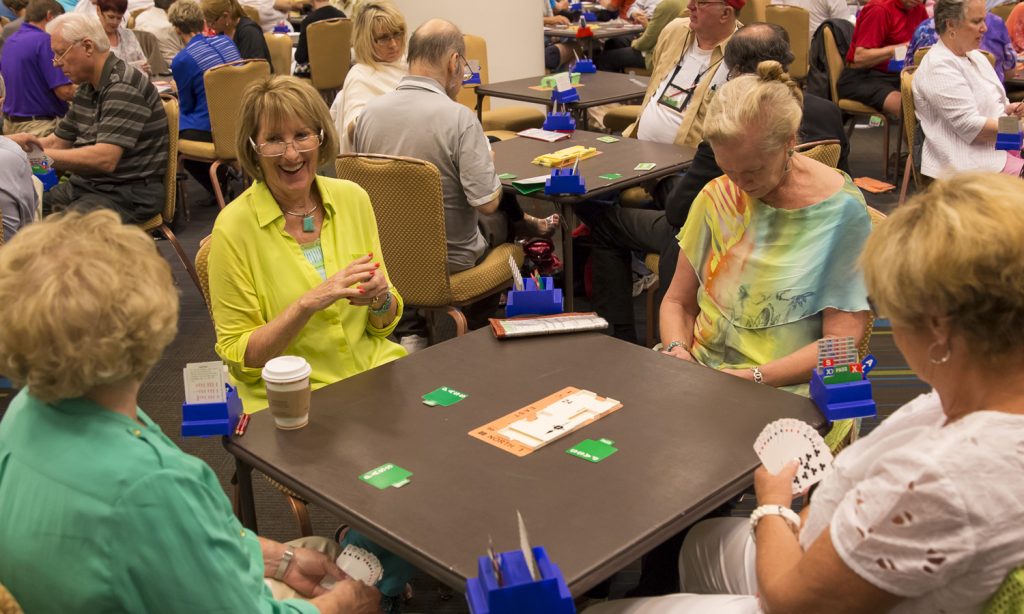New convention charts, how to use the bid boxes and more from the most recent ACBL Daily Bulletins.
5 ACBL Notices You’ll Want to Read

5 ACBL Notices You’ll Want to Read
Source: ACBL Fall NABC Daily Bulletins, November 2018.
Following are items from the Hawaii NABC Daily Bulletins and published in November 2018. First we examine the Open and the Open+ convention charts. Then a few of the most current instructions regarding slow play, bid boxes and appeals. Enjoy!
This from the ACBL website Charts, Rules & Regulations: The success of any game depends on players following universally accepted rules and protocols. Here, you can research rules and regulations for different games and tournaments.
Open Chart
The Open Chart is the rest of the charts designed from the ground up and is different from any previous chart. It is intended for most single- session games with no upper masterpoint limits. For tournament play, this means it applies primarily to sectional tournaments, but also would be in effect for open, single-session games at regionals and NABCs, such as side series events, evening session Swiss/BAM events, and so on. In knockout events with a large number of brackets, some upper- and mid-tier groups may also use the Open Chart. It is also the chart recommended for open club games to use as their governing chart. As a reminder, clubs are allowed to implement whatever rules as they see it. It is expected, however, that most clubs will use this as their default chart.
The Open Chart is fundamentally different from both the current convention charts (GCC, MidChart, etc.) and the Basic and Basic+ charts. All of the previous charts were built with the underlying assumption that everything that is allowed is specifically itemized within the chart. While this sounds good in theory, in practice it created some logistical problems.
The Open (and Open+) charts were designed differently. In addition to defining various terms with specific technical meanings in the intro to the charts, the basis of the charts is permissive. Instead of trying to create a list of all the possible things which are allowed, we instead created categories that are disallowed. The underlying assumption is that anything which isn’t specifically disallowed is, in fact, legal. Part of the reason to allow most bids is to encourage experimentation and growth. Every convention that a bridge player uses was invented at some point by a player; if we only ever allow those things which are already known, the game as we know it would grow stagnant. Trying to keep up with changes with the old methodology is impractical, while this method should allow experimentation to flourish. At the same time, with the definitions and rules being a bit more technical, the hope is that director rulings will become more consistent and less open to interpretation.
Having said this, we don’t want a complete open system where anything goes. The Open Chart guiding philosophy was a simple one: We want to allow nearly any constructive method, even if artificial. Newer methods such as playing transfers after a natural (or quasi-natural) 1♣ are allowed, as this is a constructive but artificial bid: It is easy to explain to the opponents and the concept is a familiar one. In some cases where methods are fundamentally constructive but may be unfamiliar to players and require some discussion, we have restricted the bids to board segments of six or longer (i.e., team games). An example of that would be a system that employs transfer-based opening bids, such as 1♦ opener showing hearts.
We don’t want to allow artificial destructive methods under the Open Chart as those bids can be problematic to deal with at the table. Bids such as multi, transfer preempts or other artificial weak bids are not allowed on the Open Chart. This is the biggest overall difference between the Open and Open+ charts.
There are still some restrictions in the Open Chart that are similar to the GCC. For example, 1NT openings still must have 10 HCP and a range no greater than 5 HCP. Opening bids still have strength requirements, either Near-Average for (Quasi-) Natural bids or Average for Artificial bids. Forcing pass systems and other destructive bids are not permitted.
The Open Chart may take some adjusting for players but ideally, it should be a balance between allowing innovation while keeping bidding understandable. Everything that is permissible under the lower charts is also allowed on the Open Chart, so most players don’t need to change their system. This chart doesn’t have a direct comparison to a current chart, but it lies somewhere between the current GCC and MidChart.
Open+ Chart
The Open+ Chart is intended for our highest levels of competition. The design philosophy is to be as permissive as reasonable, while still disallowing agreements which are primarily designed to disrupt the opponents. Systems such as forcing pass, very weak 1NT openers (fewer than 10 HCP), and those which employ “fert” bids that convey no information but are only used to eat up bidding space are not allowed.
The Open+ Chart can’t be directly compared with any of our current convention charts but is somewhat of a hybrid of the MidChart and Super Chart.
The Open+ Chart will be the chart governing open events of two or more sessions at regionals and NABCs. For knockout events, this chart will be used in the top bracket as well as any additional brackets with higher limits of masterpoints. While it was designed with tournament play in mind, clubs that are currently using the MidChart for their games may want to use this chart.
As mentioned above, the Open+ Chart allows most conventions to be played. Artificial preempts as a general category are legal under this chart. Like the MidChart, any pair wishing to play an artificial preempt is required to provide a written defense to the opponents. If there is a defense in the ACBL Defense Database, that defense must be printed and provided. The Open+ Chart rules allow for conventions which are not necessarily already provisioned in the Defense Database; anyone wishing to play a convention not currently in the Defense Database must submit a request to the ACBL for approval along with a suggested defense.
Artificial preempts that have a known suit are legal in all Open+ Chart events. Some examples would include transfer preempts or 2♦ showing a weak hand with both majors.
Like the MidChart, some bids are only allowed in events which have longer board segments – typically Swiss team or knockout-style events. Agreements which fall in this category are ones which may require extra discussion for defending against the bid. Notable examples of this style of bid are preempts which do not have a known suit, such as multi 2♦ (a weak two-bid in either major) or 2♠ showing a weak preempt in a minor.
Slow Play
Slow play, especially habitual slow play, is a violation of law and subject to penalty. When a pair has fallen behind, it is incumbent on them to make up the time lost as quickly as possible whether at fault or not. All players are expected to make a concerted effort to catch up when they have fallen behind, regardless of the reason for their lateness. In the absence of compelling evidence to the contrary, the director should presume that a pair finishing a round late by more than two or three minutes on more than one occasion during a session is responsible for the lateness. There is a strong expectation that the director will penalize such a pair. The size of a penalty will tend to increase for subsequent instances of slow play and for chronic or egregious slow play.
While warnings typically will be given before a penalty is assessed, failure to do so in no way limits the director’s authority to issue a penalty. Players are expected to be aware, in a general sense, of time used and remaining in a segment in which they are playing regardless of whether a clock is in use or a time announcement has been made. An excuse of “no announcement” or “no clock immediately visible” will not be considered persuasive.
In consultation with the DIC of the tournament, the TD may require that a particular pair not play in a specified segment, not play against a specified pair or not play together as a pair. The foregoing is expected to be applied only due to egregious circumstances or to unduly repetitious offenders.
An appeal of an action taken by a TD with regard to time may be taken to the Director in Charge of the tournament, and no further. For NABC+ KO events, the TD is charged with the responsibility to ensure that each KO match segment finishes within the allotted time. While a time monitor may be employed, the lack of a monitor in no way limits the TD’s authority to apply one or more of the remedies listed below.
The TD may choose to ignore an occasional minor late finish. The TD may remove one or more boards from a segment. The TD may award no score
(when neither team is more at fault), an assigned score (when a result already exists at one table which the TD wishes to preserve) or an artificial score in IMPs. Every effort should be made to remove boards before they can be played at either table, but not having done so does not preclude removing one or more later.
Appealing a ruling
Players in NABC+ events who want to appeal a director’s ruling initiate the process by speaking with the director who delivered the original ruling. The table director will fill out paperwork regarding the appeal, and the appellants will explain what they believe to be wrong with the initial ruling. From there, the case may be handled by a variety of means. When the appeals reviewer receives the case, the circumstances of that particular case will determine whether the case can be resolved by the original staff (in the case of misapplication of Law or regulation, for instance), a panel of directors, or even a committee-type hearing which could include bridge experts.
Use of the bidding box – Alerts and Announcements
When using bidding boxes, the ACBL requires that players tap the Alert strip and say “Alert” at the same time.
When making an Announcement, use the Announcement word (such as “transfer”) and tap the Alert strip at the same time. A player who Alerts or Announces a bid must make sure his opponents are aware that an Alert or Announcement has been made.








